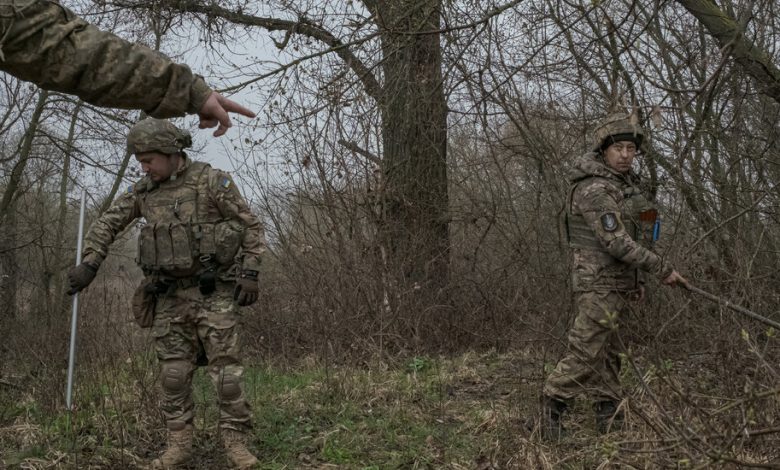Lethal Surprises Hidden in the Grass: Russia’s Trip Wires and Land Mines

With a practiced calm, a Ukrainian de-mining expert gingerly pushed aside stalks of dry grass, revealing a lethal surprise — a hand grenade rigged to a trip wire, waiting for someone to heedlessly step on it.
The discovery, near the Ukrainian town of Lyman, was just one small development in a wider cat-and-mouse struggle between mining and de-mining teams that is becoming a pivotal element in Russia’s war in Ukraine.
Mines, trip wires and booby traps are go-to defensive tools for Russia’s military, inflicting grievous wounds on infantry or stalling armored vehicles. Easy to rig, bury in dirt or cover with debris by the side of a village road, they are devilishly hard to find.
De-mining is expected to play a pivotal role in Ukraine’s anticipated counteroffensive this spring, as Kyiv seeks to push back Russian forcesand shift the momentum in the war. Its army will be advancing into dense networks of trenches, tank traps and minefields.
Ukrainian land is covered in thousands of Russian mines, trip wires and booby traps. An area four times as large as Switzerland is unsafe because of land mines, the United Nations has estimated.
They kill or maim hundreds of civilians each month. In March, land mines killed 226 civilians and wounded 724 others. Throughout Ukraine, about 350 de-mining teams work continually.
The Ukrainian government has divided mined zones into priority areas for clearance. It is encouraging technological innovation for de-mining tools, and it intends to create a for-profit market for demining services.
The World Bank has estimated clearing Ukraine of mines will cost $37 billion.
Russia has a vast arsenal of land mines, and its soldiers a rich repertoire of tricks for setting booby traps. Russia is among a few countries, along with the United States, that have not ratified a treaty banning land mines in war.
Finding them has become a well-practiced art for Ukrainian soldiers. Areas dense with trip wires, for example, will often have a dead animal nearby, as animals set them off while roaming in the forest.
The State of the War
- Leaked Documents: A trove of classified Pentagon documents reveals how deeply Russia’s security and intelligence services have been penetrated by the United States, demonstrating Washington’s ability to warn Ukraine about planned strikes.
- Ukrainian Air Defense: The leaked documents suggest that Ukraine’s air defense network could fracture without a huge influx of munitions, potentially allowing Russia’s air force to change the course of the war.
- Scrambling to Deliver Shells: Officials and analysts are questioning whether Europe can expand production from its shrunken military-industrial sector enough to provide Ukraine the ammunition it needs.
In fact, Ukrainian forces were alerted by a dead dog and a dead goat to the presence of booby traps in a thicket of brush and dry grass near a former Russian position, said the commander of a de-mining team sent to clear them. He asked to be identified only by his name and rank, Lieutenant Oleh, in keeping with Ukrainian military rules.
“There were lots of tricks here,” Lieutenant Oleh said of the minefield.
The soldiers probed the ground with fiberglass rods — lest a metal instrument trip an electrically triggered mine intended to kill de-miners. The hand-grenade rigged to a trip wire had been found earlier by colleagues before soldiers returned to detonate it safely, as it was too dangerous to defuse.
The team, operating outside Lyman, which was liberated from Russian forces last fall, found one booby trap with a trick to fool de-mining teams, a common occurrence. In this instance, it was a claymore mine — an explosive that sprays shrapnel toward its targets — that had a trip wire.
The Russians had stretched an electrical cable nearby, hinting it could also be set off remotely by a spotter. But the wire ended nearby in the grass, unconnected to any detonator. It was just a ruse to slow the de-mining work by forcing them to trace the cable.
The thicket near the position on the outskirts of a village was also rigged with jumping mines, what American soldiers in World War II called Bouncing Betties. When triggered by a footfall or trip wire, they burst a few feet into the air, then detonate in a spray of shrapnel.
“Everybody within 25 meters is guaranteed to die,” Lieutenant Oleh said.
One such device, a Russian OMZ-52 jumping mine, had killed the dog and goat.
Two distinct tasks face the Ukrainian de-mining teams. Some clear reclaimed areas so that they become safe for civilians to return. Another, more perilous, type of de-mining is carried out by military engineers, who move at the tip of the spear in assaults — walking ahead of assaulting soldiers to find paths through minefields.
Mine-clearing equipment and techniques have drawn less attention than sophisticated Western weapons like Abrams tanks, though Ukrainian officers say much hinges on these operations.
The process of mine clearing can be done manually. A de-mining expert in another small squad of engineers, Private Ivan, said he did this by taking a step and pausing to peer at a yard or so of ground in front of him. He then kneels, as the sunlight might glint off an all-but-invisible trip wire made from slender thread resembling fishing line if viewed from a different angle.
Maintaining calm is essential, he said, even if infantry commanders are clamoring for speed. In one assault last fall, he said, he safely detonated four tripwire booby traps to clear a path for assaulting troops.
Specialized mine-clearing machinery can also do the job. The chunky, lumbering Soviet-era military vehicle nicknamed the Dragon in the Ukrainian Army has flimsy armor and only one weapon: a rocket that tows a line of explosives a few hundred yards forward. Placingtheexplosives over a minefield and then detonating them clear a path for infantry or tanks to move forward.
“You focus on your work without being distracted by the sounds” of artillery and small-arms fire during the assault, Private Ivan said.
The unit of about a dozen men has had soldiers killed or gravely maimed by mines, but military rules prohibit specifying how many.
The United States has been providing military aid in the form of a similar tracked vehicle system called a Mine Clearing Line Charge, or MICLIC, seen as preparation for the spring offensive.
Both the Ukrainian and Russian militaries use anti-handling devices on anti-tank mines, which trigger the explosives if somebody moves the mine and are intended to kill de-mining teams.
The Russian military has set a type of seismically triggered anti-personnel mine, called POM-3, which detonate from the vibrations of footsteps before a de-mining expert can even walk close enough to defuse the device. The POM-3s, small green cylinders that can be spotted by an attentive soldier, have to be destroyed by shooting them from a distance.
Detonating mines or booby traps in place is a common practice. It can be done by placing a small slab of explosives nearby that the de-mining soldiers then detonate together with the mine.
For the trip wire discovered in Lyman in the thicket on a recent, rainy morning, the soldiers chose a simpler method. One positioned, ever so gently, a long rope and grappling hook to snare the trip wire, then backed off and pulled.
A boom sounded. Black smoke wafted up. A soldier then casually coiled the rope and walked out of the thicket.
Maria Varenikova contributed reporting.





